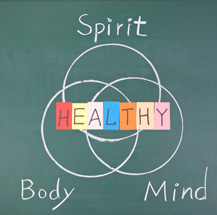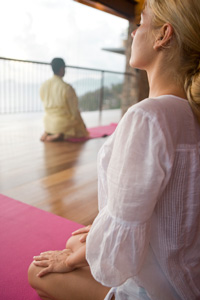By Steven Hutchings
 The happiest man in the world holds a PhD in molecular genetics, but it’s not science that brings joy to Matthieu Ricard. Rather, he’s really good at meditation. So much in fact, that he gave off gamma waves – linked to consciousness, learning, attention and memory – at levels never before seen in scientific literature in a recent experiment at the University of Wisconsin.
The happiest man in the world holds a PhD in molecular genetics, but it’s not science that brings joy to Matthieu Ricard. Rather, he’s really good at meditation. So much in fact, that he gave off gamma waves – linked to consciousness, learning, attention and memory – at levels never before seen in scientific literature in a recent experiment at the University of Wisconsin.
Just as notably, brainscans showed heightened activity in his left prefrontal cortex compared to his right, which makes him a real happy camper. Researchers believe it gives him an exceptionally high capacity for happiness and compassion, and with reduced propensity for thinking negative.
Meditation is the act of focussing attention to feel calm and bring awareness to your life. The practice has been done for thousands of years in eastern philosophies like Buddhism and is now gaining popularity in North America for its positive effects on health.
The benefits of meditation might help you as well. Many studies, and more by the year, show meditation is good for health and well-being. Meditation might help you reduce IBS, quit smoking, lower blood pressure and even hit life goals that seem unachievable.
Why You Should Meditate
You should meditate because it’s just so darn good for your well-being. While not a primary treatment for life-threatening conditions, meditation appears to benefit pain relief, brain function, blood pressure, digestion problems and much more.
In a time of growing concerns about concussions and the impact of brain injuries in football and hockey, meditation appears to help the brain, with new grey matter in regions linked to learning, memory, emotions, self awareness and perspective.
One cardiologist says meditation can help any condition caused or made worse by stress. Meditation appears to:
Boost the Immune System – Meditation might help you cut down on sick days. In one study, published in Psychosomatic Medicine, researchers gave flu shots to volunteers who meditated and those who did not. Blood tests later showed the meditating volunteers had more antibodies to the virus than the volunteers who didn’t do the practice.
Assist Women’s Health – Research links meditation to less PMS, fewer hot flashes, fewer infertility problems and even more breastfeeding. One study showed meditation helped women reduce PMS by 58%. Just as interesting, 34% of women struggling with fertility became pregnant within six months of a 10 week meditation program (with changes to exercise and nutrition).
And what the mind sees, the body believes. New mothers who meditated on images of milk flowing from their breasts more than doubled their production of it.
Develop the Brain – Studies on buddhist monks show significant gamma wave activity in areas of the brain linked to learning and happiness compared to folks who don’t meditate. These gamma waves helped attention, learning, memory, learning and conscious perception – all linked to positive emotions.
Meditation and Changes in the Brain
A 2010 study found that non-meditators who had 8 weeks of mindful meditation training were more likely than a control group to access the region of the brain responsible for ‘the here and now’ and ignore the region linked to anxiety.
 The study builds on earlier research linking this form of meditation, called mindfulness-based stress reduction (MBSR), which tied it to increased grey matter density in areas responsible for learning, memory, self-awareness and emotional regulation.
The study builds on earlier research linking this form of meditation, called mindfulness-based stress reduction (MBSR), which tied it to increased grey matter density in areas responsible for learning, memory, self-awareness and emotional regulation.
Scientists don’t know if these changes influence thoughts or actions. But we do know that lower grey matter density in the amygdala, which controls anxiety, was linked to lower stress levels as reported by the participants.
Previous research suggests that MBSR is good for overall health, both as a medical intervention for chronic pain and for stress-related illness like high blood pressure and even irritable bowel syndrome.
Mindful meditation relieves stress by providing insight – an argument further supported by the finding that MBSR was just as effective as antidepressants to prevent relapse into clinical depression.
The Art of Meditation
Meditation is a state of relaxation. The practice is done in a quiet setting and consists of slow, regular breathing, usually while sitting, for 15 to 20 minutes.
Meditation is centered on the soothing power of repetition. You’ll need to focus on breathing and tune out distractions. You might repeat a word or mantra too – they all help to induce the biological response of relaxation.
While there are many forms of meditation, two forms, concentrative and mindful meditation, are most commonly practiced.
Concentrative Meditation – An example being transcendental meditation, this focusses on a single image, sound, word, mantra or your breathing.
Mindful Meditation – The oppposite approach. Mindful meditation like MBSR hinges on everything – all feelings, emotions, sounds and images – that pass through your mind, without judging them. This approach has proven very effective for patients with IBS. In one study, women who did mindful meditation reduced severity of their symptoms by 26.4%.
Like all things, meditation takes practice. Many patients find meditating once a day for 15 minutes can help bring clarity and greater emotional wellness. Longer sessions, twice a day, may be required for biological changes, like metabolic regulation and lower blood pressure.
You’ll know it’s working if you get feelings of calm, warmth and heaviness when you meditate. If not, you haven’t gone deep enough. Give it more time, or consider taking a meditation class.
How to Meditate
Transcendental meditation can be done at home and without instruction. You’ll want to take a class to learn mindful meditation. We’ll cover some basic steps for the former here.
 Meditation is a habit. Repetition is more important than form, at least when you’re beginning, so make time to meditate with the following steps:
Meditation is a habit. Repetition is more important than form, at least when you’re beginning, so make time to meditate with the following steps:
Commit to Just Two Minutes Daily – Go ahead and do five minutes or longer if you like, but feel free to start meditating for just two minutes a day. The key is to stick to it and make it a pattern.
Choose a Time and Trigger – You don’t have to nail this down to the same minute, but try to meditate at the same time in your daily regimen, like after your first cup of coffee or during lunch.
Find a Quiet Place – You’ll need to be alone and without distractions to meditate. Some people find it best to meditate early in the morning, before others wake up, or a bench in the park or spot on the beach. Granted, it might not be possible to avoid everyone – a few people walking past the bench is fine – but you’ll need to be in a place where no one will interrupt for a few minutes.
Sit Comfortably – Be comfortable when you meditate. The classic image of buddha sitting cross-legged might work for some folks but it’s not a requirement. A couch, chair or sitting on a pillow with your back to the wall are further ways you might get comfortable.
Meditate For Two Minutes – Baby steps. We’re trying to get you in the habit of daily meditation. That’s easier to do with a regimen you’ll stick to, so begin with just two minutes a day. Nudge that higher, to five to seven minutes once you’ve done this for seven days in a row, then 15 minutes at two weeks and 20 minutes after a month. Don’t skip days!
Focus On Your Breathing – Focus on your breath to meditate. Breathe in slowly, through your nostrils, then in to your throat, and lungs and belly. Sit up straight, with your eyes open and looking at the ground. You can close your eyes if you like. Follow your breath on the way out. Count them if it helps – one breath in, two breathe out, three breathe in, four breathe out.
Start over if you lose count. If your mind wanders – and it probably will – pay attention to where it goes, them gently guide it back to your breathing. Repeat this process for the first few minutes.
Remember, meditation takes practice. This won’t come naturally the first several days, but stick to it. You’ll get better, especially if you do it each day and at the same time with the same trigger.
Training For Mindful Meditation
You’ll need training to learn mindful meditation if you’re interested in going this route. MBSR is a highly systematic approach to meditation, and with a different emphasis. The rewards will be great, but you’ll need to take a class and stay with the program.
 Mindful meditation training typically consists of weekly group sessions, at roughly eight weeks, and often a full day retreat. The system may include gentle exercises, like yoga, sitting meditation and a ‘body scan’, in which you’ll devote time each day to tune in to your body’s senses.
Mindful meditation training typically consists of weekly group sessions, at roughly eight weeks, and often a full day retreat. The system may include gentle exercises, like yoga, sitting meditation and a ‘body scan’, in which you’ll devote time each day to tune in to your body’s senses.
Mindful mediation centers on the ‘ebb and flow’ of your emotions and sensations. You’re not judging them or altering the experience – an important distinction that makes MBSR especially useful for pain relief.
Note you don’t have to be buddhist to meditate. Meditation can be a secular program and MBSR in particular is designed for health care applications. You’ll find many videos on how to do mindful meditation on YouTube and iTunes but it’s best to do this with formal training and in a group setting. Google ‘mindful meditation classes’ to find a course in your area.
+Steven Hutchings




